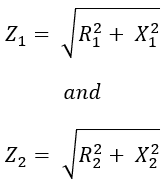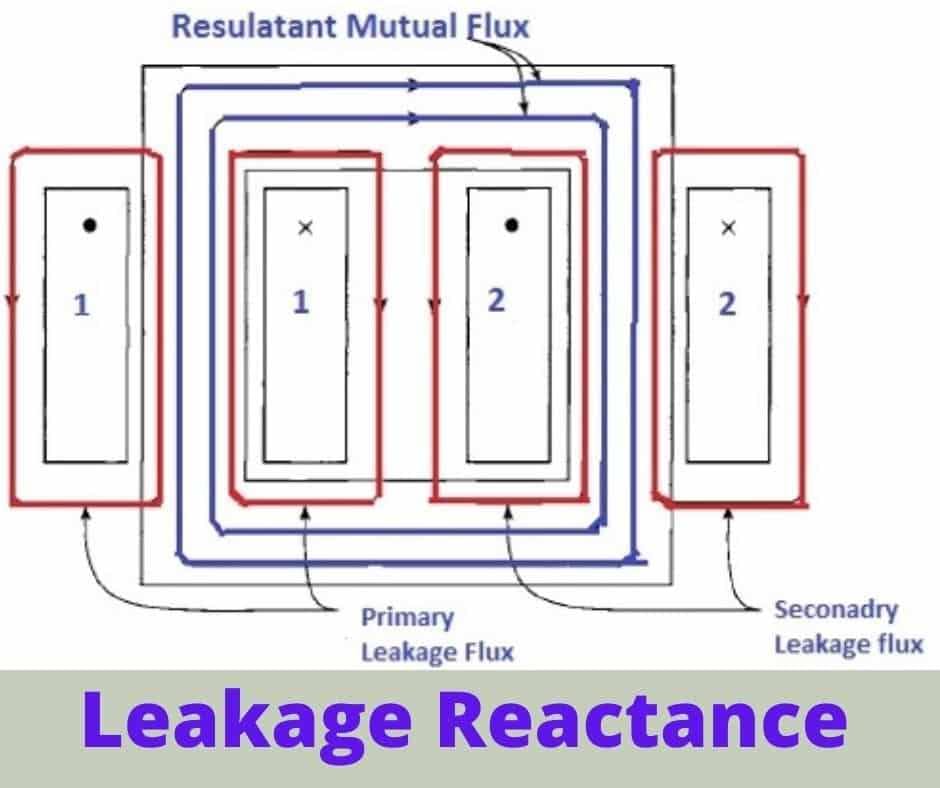Table of Contents
1. Introduction
A transformer is a key device in electrical power systems. It moves electrical energy from one circuit to another using electromagnetic induction. In an ideal world, transformers would work perfectly with no losses or voltage drops. But in real life, they have limits. One important factor is leakage reactance. This affects how well a transformer controls voltage, handles heavy loads, and deals with short circuits. Knowing about leakage reactance helps engineers make transformers that are more reliable and efficient.
2. What is Leakage Reactance?
Leakage Reactance in Transformer happens when part of the magnetic field made by one winding of a transformer doesn’t reach the other winding. This “leakage flux” travels through air, insulation, or other parts instead of the core. Because this magnetic field doesn’t help transfer power, it acts like a barrier to AC.
3. How Leakage Reactance Happens
When AC flows through the primary winding, it creates a magnetic field. Most of this field links to the secondary winding through the core. But some of it—called leakage flux—only stays around the winding that made it. This happens because of the shape of the windings, the space between them, the insulation, and other design details.
Leakage Reactance in Transformers
In a practical transformer, the total magnetic flux generated by each winding can be divided into two distinct components with different paths and effects:
- Mutual Flux – This essential component travels through the high-permeability magnetic core and links strongly with the opposite winding. Its main function is to produce a mutually induced EMF in the other winding, which forms the basis of transformer action.
- Leakage Flux – This part of the flux remains confined to the space around its own winding, never coupling with the other winding. Its value depends on factors such as coil spacing, arrangement, and insulation structure.

The leakage flux in each winding produces a self-induced EMF that acts like an internal voltage drop and affects performance:
- In the primary winding, leakage flux generates an EMF that opposes the applied input voltage, thus reducing the voltage available for mutual induction.
- In the secondary winding, leakage flux generates an EMF that opposes the mutually induced EMF, reducing the voltage supplied to the load.
Representation Using Leakage Reactances
In a practical transformer, the effect of leakage flux is represented by adding leakage reactances in series with the windings. These are:
- X₁ → Leakage reactance of the primary winding
- X₂ → Leakage reactance of the secondary winding
These reactances are fictitious components used in the equivalent circuit model to account for the voltage drops caused by leakage flux.

Practical Transformer Equivalent Circuit
A practical transformer is thus represented as an ideal transformer with series elements:
- R₁, X₁: Primary resistance and leakage reactance
- R₂, X₂: Secondary resistance and leakage reactance
This configuration, shown in Fig. 3.16, clearly illustrates how leakage reactances influence voltage distribution, with all polarities indicated as instantaneous values.
4s up, the leakage reactance also goes up.
Formula for Leakage Reactance in Transformers
Leakage reactance (X) in a transformer can be calculated using:
Where: X = 2π × f × L
- X = Leakage reactance (Ohms)
- f = Supply frequency (Hertz)
- L = Leakage inductance (Henrys)
How it works:
- The leakage inductance L comes from the leakage flux that links only with one winding.
- Once you know L, you can find X at a given frequency f.
For practical measurements, X is often found using a short-circuit test on the transformer:
Where: X = √(Z² − R²)
- Z = Total short-circuit impedance (Ohms)
- R = Winding resistance (Ohms)

This formula gives the leakage reactance value used in transformer modeling and design.
Factors Affecting Leakage Reactance in Transformers
Leakage reactance in a transformer depends on several design and construction parameters. These factors influence the amount of leakage flux that does not link both windings and, therefore, impact the voltage regulation and short-circuit performance of the transformer.
1. Spacing Between Windings
- Greater physical separation between the primary and secondary windings increases the leakage flux path, thereby increasing leakage reactance.
- Close winding arrangements (such as sandwich windings) reduce leakage reactance.
2. Winding Geometry and Shape
- The type of winding arrangement—cylindrical, disc, helical, or sandwich—affects the distribution of leakage flux.
- Windings designed for compact coupling reduce leakage paths.
3. Number of Turns
- Leakage reactance is proportional to the square of the number of turns. More turns increase the total leakage flux linkage.
4. Winding Height and Diameter
- Taller windings or larger diameters can alter the leakage field pattern, potentially increasing leakage reactance if not carefully designed.
5. Core Window Size
- A larger core window can allow for more separation between windings, increasing leakage reactance unless mitigated by winding placement.
6. Insulation Thickness
- Thicker insulation between windings increases their physical distance and thus the leakage flux path length, increasing leakage reactance.
7. Load Conditions and Frequency
- While leakage reactance is mainly determined by construction, its effect on voltage drops increases with load current.
- Leakage reactance is directly proportional to operating frequency.
8. Use of Magnetic Shunts
- Some special transformers intentionally use magnetic shunts to increase leakage reactance for current-limiting purposes.
Impact of Leakage Reactance in Transformer Performance
Leakage reactance plays a significant role in determining how a transformer behaves under load conditions. While it is an unavoidable feature in practical transformers, its magnitude can strongly influence performance parameters such as voltage regulation, short-circuit current, and fault behavior.
1. Voltage Regulation
- Higher leakage reactance leads to greater voltage drops under load, resulting in poorer voltage regulation.
- In applications where a constant output voltage is crucial, low leakage reactance is preferred.
2. Short-Circuit Current Limitation
- Leakage reactance acts as an internal impedance, limiting short-circuit currents.
- Transformers designed for arc welding or furnace operations may intentionally have high leakage reactance to protect equipment and control current flow.
3. Load Sharing in Parallel Operation
- In parallel operation, transformers with mismatched leakage reactances will not share loads proportionally.
- Proper design ensures equal or proportionate load sharing by keeping leakage reactances balanced.
4. Power Transfer Capability
- Excessive leakage reactance reduces the effective voltage applied to the load, limiting power transfer.
- Optimized leakage reactance ensures efficient energy delivery without excessive drop.
5. Stability in Special Applications
- Some applications, like current transformers or high-leakage distribution transformers, use controlled leakage reactance to improve stability and limit transients.
Measurement of Leakage Reactance in Transformers
The leakage reactance of a transformer can be determined through testing procedures that isolate its effects from other parameters, such as magnetizing reactance. The most common method is the short-circuit test.
1. Short-Circuit Test Procedure
- Purpose: To measure the equivalent series impedance (resistance + leakage reactance) referred to one side of the transformer.
- Setup: The secondary winding is short-circuited using a thick conductor or a shorting link.
- Input Voltage: A reduced voltage is applied to the primary winding—typically just enough to circulate rated current in the windings (usually 5–10% of the rated voltage).
- Measurements:
- Input voltage (Vsc)
- Input current (Isc)
- Power input (Psc) using a wattmeter
- Calculations:
- Equivalent impedance:
- Equivalent resistance:
- Leakage reactance:
2. Key Points
- The magnetizing branch can be neglected because the applied voltage is very low, resulting in negligible core flux.
- Leakage reactance is usually expressed as a percentage based on the rated voltage.
- Measurements can be referred to the primary or secondary side, depending on design calculations.
3. Applications of the Test
- Determining voltage regulation performance
- Calculating short-circuit currents for protection coordination
- Ensuring parallel operation compatibility between transformers
Reducing or Controlling Leakage Reactance in Transformers
Leakage reactance is a natural part of how transformers work, but engineers can make it smaller or control it through smart design choices. The aim is to have just the right amount for the job the transformer will do.
1. Placing Windings Closer Together
- Putting the primary and secondary windings close to each other makes it easier for magnetic flux to pass between them.
- This helps reduce leakage reactance.
2. Layering the Windings
- Arranging the primary and secondary windings in alternating layers (like a sandwich) improves magnetic connection.
- This method is often used in distribution transformers to lower leakage reactance.
3. Shaping the Windings Well
- Choosing winding shapes that give more contact area between coils improves the magnetic link.
- Special designs like disc or helical windings can help reduce leakage.
4. Keeping Insulation Thin (But Safe)
- Too much insulation between windings makes them farther apart and increases leakage reactance.
- Using strong, high-quality insulation means it can be thinner but still safe.
5. Changing Magnetic Shunts
- Some transformers, like those for welding, use magnetic shunts to increase leakage reactance on purpose.
- Removing or reducing the size of these shunts will decrease leakage reactance.
6. Filling the Core Window Better
- Making sure windings take up more space in the core window leaves less space, which helps lower leakage.
7. Matching Transformers for Parallel Use
- When two transformers work together, they need similar leakage reactance to share the load evenly.
Real-Life Uses of Controlled Leakage Reactance in Transformers
Usually, engineers try to make leakage reactance small for better efficiency, but sometimes they purposely increase or adjust it for a reason. Here are some situations where controlling leakage reactance is helpful:
1. Welding Transformers
- Extra leakage reactance helps limit the welding current.
- This keeps the electrode from overheating and makes welding safer.
2. Current-Limiting Transformers
- High leakage reactance can reduce the size of short-circuit currents.
- This protects machines and means smaller breakers can be used.
3. Furnace Transformers
- Used in electric arc furnaces that need high current but steady voltage.
- Leakage reactance helps keep the arc stable.
4. Testing Transformers
- Some test setups need a lower and steady short-circuit current.
- Controlled leakage reactance makes testing safer and more consistent.
5. Sharing Power Between Transformers
- When two transformers work together, matching their leakage reactance helps them share the load evenly.
6. Induction Heating Systems
- Transformers with planned leakage reactance help control the current in the induction coil.
Conclusion
Leakage reactance can be both a limitation and a useful design feature. While excessive leakage reactance can harm voltage regulation and efficiency, certain applications intentionally incorporate it for safety or functional purposes. By understanding and controlling leakage reactance, engineers can optimize transformer performance for specific needs.
FAQ
What is leakage reactance in a transformer?
Leakage reactance is the opposition to AC current in a transformer caused by leakage flux that does not link both the primary and secondary windings.
What is the formula for leakage reactance?
Leakage reactance is expressed as:
Xₗ = 2πfLₗ
where f is the frequency (Hz) and Lₗ is the leakage inductance (H).What factors affect leakage reactance?
Key factors include the winding arrangement, spacing between windings, core design, winding dimensions, and operating frequency.
How is leakage reactance measured?
It is typically measured using a short-circuit test, where one winding is shorted and a reduced voltage is applied to measure impedance.
Can leakage reactance be controlled or minimized?
Yes. It can be reduced by optimizing winding placement, decreasing the gap between windings, and enhancing core design.
